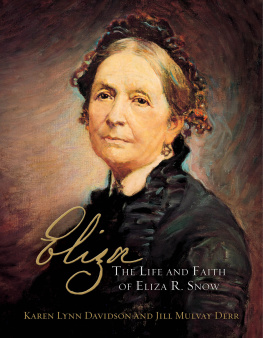Table of Contents
INTRODUCTION
Eliza Potter:
Black Working Woman,
Author, and Social Critic
Chapter 5. Leaving Saratoga
Burning of the Baggage Car
Visit to New York
APPENDIX A
Biographical Information on
Eliza Potter (1820?1893)
APPENDIX B
Newspaper Reviews of
A Hairdressers Experience in
High Life

2009 THE UNIVERSITY OF NORTH CAROLINA PRESS
All rights reserved
Manufactured in the United States of America
Designed by Courtney Leigh Baker and set in Dante
with Edwardian Script and Bickham swashes for display
by Tseng Information Systems, Inc.
The paper in this book meets the guidelines for permanence
and durability of the Committee on Production Guidelines
for Book Longevity of the Council on Library Resources.
The University of North Carolina Press has been a
member of the Green Press Initiative since 2003.
Library of Congress Cataloging-in-Publication Data
Potter, Eliza.
A hairdressers experience in high life / Eliza Potter ;
edited and with an introduction by Xiomara Santamarina.
p. cm.
Includes bibliographical references and index.
ISBN 978-0-8078-3335-3 (cloth : alk. paper)
ISBN 978-0-8078-5982-7 (pbk. : alk. paper)
eISBN : 9780807898666
1. Potter, Eliza. Hairdressers experience in high life.
2. United StatesSocial life and customs17831865.
3. WomenUnited StatesHistory19th century.
4. Potter, Eliza.
5. African AmericansOhioCincinnatiBiography.
6. Beauty operatorsOhioCincinnatiBiography.
7. Cincinnati (Ohio)Biography.
I. Santamarina, Xiomara. II. Title.
E166.P86 2009
973.6'092dc22
[ B ]
2009018547
CLOTH 13 12 11 10 09 5 4 3 2 1
PAPER 13 12 11 10 09 5 4 3 2 1
Acknowledgments
I would like to thank the various individuals and institutions that made this edition possible. For their generous and timely financial support, my thanks go to the Institution for Research on Women and Gender and the Office of the Vice President for Research at the University of Michigan. For their assistance, I wish to thank Pen Bogert, Filson Historical Society, Louisville, Kentucky; Bill Markley, Ohio Historical Society, Columbus; Chuck Kallendorf, Cincinnati Law Library Association, Cincinnati, Ohio; Jim Pritchard, Kentucky Department of Archives and Libraries, Frankfort; Theresa Leininger-Miller, University of Cincinnati; Stephen Middleton, North Carolina State University, Raleigh; the staff at the William L. Clements Library, University of Michigan; Emily Lutinski; and John Ernest. I am also grateful to Sian Hunter and the University of North Carolina Press production staff for their unfailing patience and support of this project during its long gestation. Finally, Robert S. Levine offered invaluable feedback and much-needed humor during this entire process; gracias, compai.
A Note on the Text
This volume reprints the 1859 first edition of A Hairdressers Experience in High Life, published in Cincinnati by Rickey and Mallory. I have silently corrected obvious printers errors and the placement of some punctuation marks; otherwise, this edition retains mid-nineteenth-century usages and spellings, as well as Potters at times idiosyncratic syntax. I have annotated proper names and locations, as well as noteworthy events, when it has been possible to do so.
INTRODUCTION
Eliza Potter
Black Working Woman, Author, & Social Critic
This edition of A Hairdressers Experience in High Life (1859) brings new visibility to a black womans autobiography that challenges many of our ideas about nineteenth-century African American history and literature. A firsthand account of work, race, and femininity, A Hairdressers Experience speaks to the possibilities for working womanhood that dressing white womens hair offered a black working woman in the United States before the Civil War. The author, Eliza Potter, was a freeborn African American woman who migrated west from New York in the 1830s to become one of antebellum Cincinnatis most popular hairdressers. Even though many in her day devalued black womens work, Potter based her claims to public authority over her clients and readers in her work: her book offers modern readers the critical voice of a working woman who deftly manages to turn the tables on her white elite female clientswomen who by virtue of their race and class were considered her social superiors. The fact that she earned high wages and accumulated quite a bit of money as one of the nations earliest beauticians to white social-climbing women when the majority of black women worked as laundresses at the bottom of the occupational ladder only enhances the piquancy of Potters text.
A Hairdressers Experience provides insights into the ways that black working womenone of the nations most marginal populationswere able to shape their identities as entrepreneurs and social critics, long before the twentieth-century advent of the better-known Madame C. J. Walker. Published in Cincinnati, a border city on the Ohio River between North and South, on the eve of the Civil War, this autobiography illustrates how black women authors addressed white reading publics outside the abolitionist circles with which they were most closely associated at the time, when they were viewed principally as reformers working for the common good as abolitionists, teachers, and temperance activists. It exemplifies one working womans engagements with the political contradictions at play in a rapidly industrializing nation that strenuously promoted democratic equality, even as it perpetuated slavery, racism, and economic disparities.
This edition also offers many book reviews of A Hairdressers Experience, reprinted in appendix B, to help modern readers place this text into a reception context that speaks to its significance, then and now.
Eliza Potters authorship illustrates perfectly how black authors drive for social legitimacy in a racist nation encompassed multiple identities and negotiation with multiple publics, or reading audiences. While many black authors of her time were most concerned with the dynamics of race and U.S. racial domination, Potter based her life story on her successful work history and the mobility this work offered. Because her travels offered insights into the sufferings and domestic bitterness of elitesand, in particular, of elite white womenPotter the author carved out a literary space that features a black working woman at the center, rather than at the margins, of the eras transformations in gender, race, and class structures.
This representation of herself as a black working woman observer-participant speaks to Potters aspirations for local status as an arbiter of social relations in modernizing Cincinnati: she claims to be a social critic who can speak to the social anxieties associated with the eras commercial revolutions when she confronts abolitionism and its politics of racial representation (from an antislavery perspective), and when she exposes the often-overlooked phenomenon of black ownership of slaves in the Deep South. The critical vantage point of a social critic enables Potter to offer her readers unusual analyses of slavery and southern interracial relations that foreground the role of class in the formation of free blacks status in the South and the contributions free black workers (about 2 percent of the Norths population) made to the nations industrialization. Lastly, as a self-identified working woman, Eliza Potter authored a work and travel narrative that celebrated national narratives of economic individualism, westward expansion, and manifest destiny, even as it also testified to the erosion of workers authority in an increasingly unequal society. Whether derived from her mobility, her skilled occupation, or simply her personal qualities, Eliza Potter offers insights into black authors diverse experiences and the ways in which these experiences contradict our expectations of a unitary black subject and of racially representative texts.










